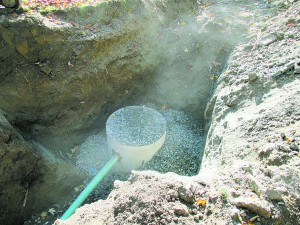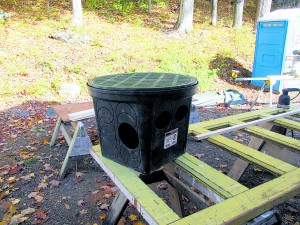
Components of an interior drainage system: drainage mat on the walls and floor; rigid insulation and vapor barrier on the floor prior to pouring the concrete slab; a sump hole.
By Michael Goetinck
Over the course of this summer I did a lot of rot-related repair work. This fall I’ve done several energy audits in houses with “bulk water” problems. The sources ranged from basement flooding (three to four inches of standing water) to roof-related leaks, to continual soaking of siding and steps. The necessary repairs and corrective measures range from excavation to correcting flashing details to mitigating splash. All of these problems could have been avoided through proper attention at the time of original design or construction. I this article, I’m going to review some common basement problems and what to do about them. In the next few articles I’ll discuss roofs, siding, and steps.
Basement flooding is a common enough occurrence that many homeowners assume that it’s inevitable or unavoidable. This may have been true when rubble stone or dry stone foundations were the norm, but dry basements and crawlspaces are possible with materials and techniques available today. The water can be managed externally, internally, or both.
External water management can be accomplished by installing gutters that capture water as it runs off the roof and direct it away from the building. The down spouts can be tied to a perimeter drain if it exists. The most appropriate gutters for our region are metal gutters with a top or cover that allows leaves, twigs, snow, and ice to run over the top of the gutter while still allowing the water to enter and be carried through to the exit drain. These gutters have sturdy attachments which prevent them from being torn off by snow or ice.
If the basement is getting flooded because of ground or surface water, the most effective means of keeping the basement dry is to install an exterior perimeter drain at the footing or base of the foundation. The ditch should be lined with landscape fabric to prevent sediment from clogging the pipes. Leave enough extra fabric to be able to fold the cloth back over the trench after it’s been filled. The pipes should be as close to the base of the foundation as possible and pitched ¼ inch per foot all the way to daylight or a catch basin. The trench is backfilled with crushed stone and the landscape cloth is then folded back over the filled trench. It can be top-dressed with finer stone or soil and grass (although this is less effective than leaving the stone exposed).
Internal basement water management assumes that some water is going to get past the external drainage or that external drainage is not practical or possible. The most effective method I’ve come up with is to use drainage mat on the walls and floors of the basement to collect and direct water to a sump which drains to daylight. If that isn’t possible then a pump can be installed to move the water out of the sump. The drainage mat is then covered by a vapor barrier, which in turn is covered by rigid insulation (typically polystyrene) on the floor and dense pack cellulose in a framed wall around the perimeter. The walking surface can be either wood or concrete installed on top of the rigid insulation. In the case of a house with a small year-round spring running in the basement, I supplemented the drainage mat with four-inch perforated drain pipe.
As a courtesy to your neighbors, please make sure you’re not directing any of your bulk water toward their house or driveway. If surface run-off or a daylight drain is going to cause them to inherit your water install a catch basin well below grade.
Wet basements and crawlspaces affect the entire house. They can lead to structural problems; mold and mildew; and poor indoor air quality in conventional and high performance construction, in some cases to the point where the house can become uninhabitable.









Leave a Reply